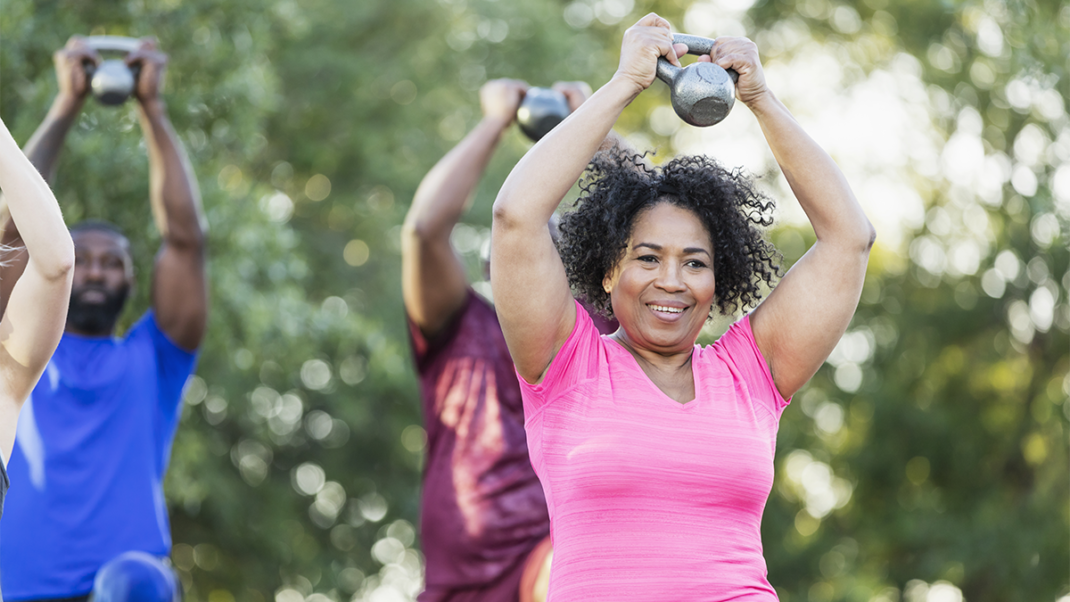Training the Novice Triathlete
Designing a three-pronged program that targets endurance, core stability and flexibility can reduce your client's potential for injury.
USA Triathlon estimates that 150,000– 250,000 people in the United States try a multisport event each year. The organization estimates that its membership weighed in at approximately 15,000 athletes in 1994; just 10 years later, the count had topped 53,250. Jordan Metzl, MD, a sports medicine physician at the Hospital for Special Surgery in New York City and an avid triathlete, believes that this surge in popularity is due to the “realization that the wear and tear on the body is much less in triathlon training than in running alone; triathlon training encourages both strength and cardiovascular conditioning.”
A triathlon is an individual sport consisting of three legs: swimming, cycling and running. Course distances vary, from beginner (sprint) to advanced (Ironman®). Today, hybrid races have formed, including team races that may entail kayaking or in-line skating in place of one of the traditional disciplines. This article will focus on the training needs of the novice triathlete.
Typical Causes and Types of Injury
Since scientists are still catching up to the fast-growing trend of triathlon racing, more data are needed on injuries that occur, both in race preparation and on the actual race day. Researchers already know that a significant relationship exists between injury and the competitor’s weekly training hours, performance level and age. Shaw and colleagues (2004) found the following statistical associations between hours of training and injury:
- For nonelite athletes, the likelihood of sustaining an injury was least when training for 8–10 hours per week—specifically, cycling for 5–6 hours and running for 3–4 hours. Time spent on swim training did not appear to affect injury risk.
- Athletes with a higher number of training hours were more susceptible to suffering a muscle-tendon injury.
According to a study by Egermann and colleagues (2003), older athletes tend to sustain more fractures, while high-performance athletes (Ironman-level racers) experience more contusions/abrasions and muscle-tendon injuries.
Injuries do not appear to be influenced by gender (Egermann 2003).
Triathlon competitors are exposed to varying environmental conditions (e.g., water temperature, terrain and attire) that influence a broad range of complications. Dallam and colleagues (2005) found that triathletes may experience a variety of medical conditions, including muscle cramping, heat illness, postural hypotension, excessive exposure to ultraviolet radiation, musculoskeletal injuries and trauma, gastrointestinal problems, bacterial infection, immunosuppression, sympathetic nervous system and psychological exhaustion, and hemolysis. In longer races, these medical conditions may be intensified by the effects of hyponatremia.
Improving the Odds
To reduce potential complications, personal trainers should focus on physical preparation and musculoskeletal-injury prevention. In a study by Burns and others (2003), 50% of triathletes sustained an injury in the 6-month preseason period; for that 50%, there was an average injury exposure rate of 2.5 for each 1,000 training hours. Overuse accounted for 68% of preseason injuries reported. During the competition season, 37% of triathletes were injured, but the average injury exposure rate was higher: 4.6 per 1,000 training hours. Overuse was again the main culprit, accounting for 78% of reported competition-season injuries.
A reduction in these high injury rates may be facilitated by well-rounded strength, flexibility and cardiovascular training programs. Exact cardiovascular training schedules (hours per week of cycling, swimming and running) should be designed in accord with the chosen race distance and the individual’s goals. This aspect of the training is complex, and attention to detail is essential. (See www.trainingpeaks.com and www.tri fuel.com for assistance in developing these parameters.)
Strength training and flexibility exercise are of utmost importance in injury prevention. As you begin designing a program, think about what triathletes need:
- To finish a triathlon, they need endurance. Their muscles need to be strong and able to maintain strength over time.
- To maintain athletic posture throughout the race (and thereby prevent injury caused by poor form), triathletes need core stability and flexibility, which enable them to efficiently transfer power and strength to the extremities and reduce stress on the joints.
The Strength Training Program
To avoid overwhelming your client, make the strength training routines time-efficient. The triathlete already has a rigorous workout program of swimming, biking and running to fit into a busy life! Also, to avoid injury, utilize periodization. Vary the program, dividing it into phases that highlight strength gains, power gains and—during racing season—strength maintenance.
Using traditional periodization methods, vary the amount of resistance, the number of reps and sets, and the rest time. Consider the following example.
Strengthening Phase. This phase may include a midrange to higher number of reps (8–15) and 2–3 sets. Use an adequate amount of resistance to fatigue the muscles within the suggested number of repetitions.
Power Phase. Once the athlete has established a good strength base, you can focus on increasing power through a lower number of reps (5–8) and 2–4 sets. Choose a level of resistance that will exhaust the muscles within the suggested repetition range. Power strengthening sessions increase explosive power during swimming, running and cycling. They can be done in conjunction with speed sessions (i.e., at the track) or strength sessions. It is important to implement a solid strength training program before beginning any power sessions.
Strength Maintenance. This phase takes place during the season. Use more reps (12–15) and 2–3 sets, again using enough resistance to fatigue the muscles within the suggested repetition range.
Suggested Strength Training
These exercises may be used in addition to a general strength training program. The highlighted muscle groups and movements accentuate sport-specific areas in an attempt to prevent injury. To focus on endurance, keep rest times short (about 30 seconds).
Lower Body. The number of repetitions will vary depending on the phase in the training schedule.
1. lunges and step-ups
- Type: straight line and multiplanar.
- Purpose: to increase power and strength in the hip and knee extensors.
- Translate to: kicking during swimming, pedaling during cycling, and the push-off during running.
2. hip abduction and adduction
- Type: with cables, or sidelying with ankle weights.
- Purpose: to increase strength and improve balance of the hip musculature.
- Translate to: stabilization of the hips and pelvis during running.
3. ankle plantarflexion and dorsiflexion
- Type: calf raises, toe raises, calf presses.
- Purpose: to reduce calf/shin injury.
- Translate to: kicking during swimming, pedaling during cycling, and proper running stance.
Upper Body. The number of repetitions will vary depending on the phase in the training schedule.
1. shoulder external and internal rotation
- Type: with cables and/or free weights.
- Purpose: to increase rotator cuff strength.
- Translate to: stabilization of the humeral head in the glenoid fossa (“socket”) of the shoulder during swimming.
2. scapular retraction
- Type: rows, prone shoulder horizontal abduction, lat pull-downs.
- Purpose: to maintain balance in shoulder musculature.
- Translate to: maintenance of balance between anterior and posterior upper-body muscles in swim training, thereby reducing shoulder injury.
Core Stability. Each exercise shares the goal of improving the stability of the foundation from which the extremities move.
1. plank hold (2–3 reps, hold 30–60 seconds)
- In prone position, place hands directly under the shoulders and press up into a push-up position.
- Maintain a straight line from shoulders to heels.
- Continue to inhale and exhale throughout the hold, keeping abdominals tight.
2. hover (2–3 reps, hold 15–30 seconds)
- In prone position, place elbows directly under the shoulders and press up into a “hover” position while maintaining a straight line from shoulders to heels.
- Exhale while pressing up into hover position, then comfortably inhale and exhale while holding the position, keeping abdominals tight.
3. plank hold with alternating leg lifts (2–3 sets, 8–12 reps per side)
- Position as in standard plank hold, above.
- Keeping the back straight, alternate hip extensions, exhaling as the leg is lifted.
The Flexibility Program
Increasing flexibility will help correct postural dysfunctions as well as reduce the strain caused by abnormal muscular pull on joints and tendons. Use your favorite stretches, making sure to include the muscle groups famously tight in triathletes. I cannot emphasize enough how important it is to keep the gastrocnemius-soleus complex and anterior tibialis muscles flexible; doing so will minimize the possibilities of shin splints and Achilles tendonitis!
Here is a list of important muscle groups to stretch in the average novice triathlete:
- gastrocnemius-soleus complex
- quadriceps
- hamstrings
- hip flexors
- iliotibial band
- lower back
- trapezius (especially upper traps)
- triceps
- forearm flexors and extensors
- latissimus dorsi
- rhomboids
- pectorals
Other Factors in Injury Prevention
Many components must fall in line for the successful completion of a triathlon. Two major components include appropriate shoe wear and sport form/technique.
Shoes. A triathlete who does not have the proper equipment is at risk for injury. It is essential that your client wear suitable shoes for biking and running. If you or your client is unsure about which shoes may be best, contact a local running-shoe store. These shops usually have dedicated, informed salespeople ready to help.
Form/Technique. Improper technique may occur when fatigue sets in and the athlete gets sloppy. On the other hand, perhaps the athlete never had proper form. If your client complains of a sore shoulder, for example, it is possible that his or her swimming stroke needs to be adjusted. In this case, you could suggest that your client contact a local YMCA or a private club for a refresher class or “form-checking” session. Local running, biking or swimming coaches can make valuable changes in as little as one or two sessions.
Share these helpful hints with your clients to prepare them for a successful race day:
- Look ahead at the weather report and double-check race gear and attire to make sure they are suitable for lower temperatures or wet conditions if necessary.
- Perform a last-minute safety check on equipment, perhaps taking your bike to a local bike shop for a checkup.
- Speak with a physician or a nutritionist about appropriate fluid replacement for your racing level and your body; this will ensure that you are drinking enough, but not too much.
- Visit the course location in the days before the race to reduce the chances of getting lost come race day and to ease any prerace jitters.
References
Dallam, G.M., Jonas, S., & Miller, T.K. 2005. Medical considerations in triathlon competition: Recommendations for triathlon organisers, competitors and coaches. Sports Medicine, 35 (2), 143–61.
Egermann, M., et al. 2003. Analysis of injuries in long-distance triathletes. International Journal of Sports Medicine, 24 (4), 271–76.
Shaw, T., et al. 2004. Training patterns and sports injuries in triathletes. Journal of Science and Medicine in Sport, 7 (4), 446–50.





